Global frozen processed food market is estimated to be valued at USD 77.33 Bn in 2025 and is expected to reach USD 95.17 Bn by 2032, exhibiting a compound annual growth rate (CAGR) of 3.0% from 2025 to 2032.
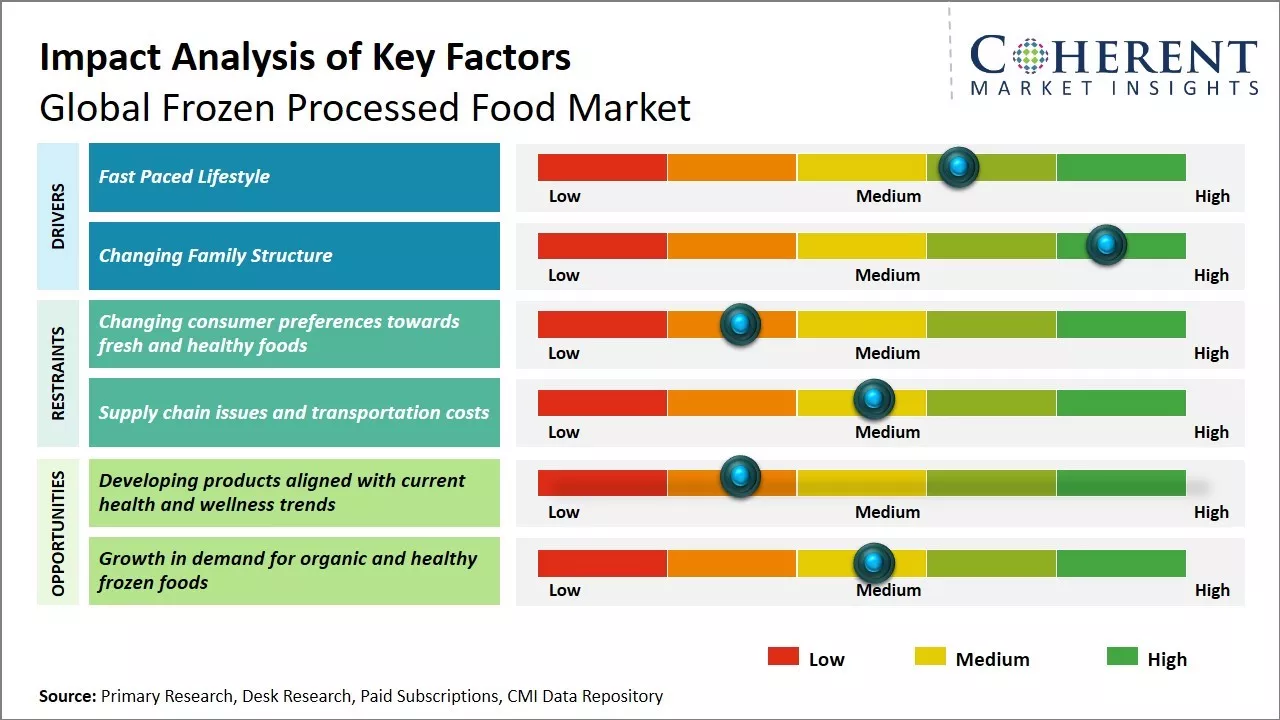
Discover market dynamics shaping the industry: Request sample copy
Over the forecast period of 2025-2032, global frozen processed food market is expected to witness a positive growth trend. Consumers have become more health conscious and prefer food items that are quick and easy to prepare without compromising on nutrition and taste. The rising global demand for convenience food influenced by fast-paced lifestyles has been a major factor driving the consumption of frozen food products. As living standards and disposable incomes continue to increase globally, this trend is likely to further propel the market growth and expansion of frozen processed food offerings across key regions.
Fast Paced Lifestyle
The fast paced lifestyle of people globally has significantly contributed to the rise of the frozen processed food market in recent years. With people's schedules getting busier due to long working hours, heavy traffic commute and other daily activities, they have little time left for cooking meals from scratch on a daily basis. Frozen processed foods provide a convenient solution as they can be stored for long durations and prepared quickly with little effort. These foods only require reheating in microwave or oven before serving. This trend is particularly prominent among working professionals residing in urban areas. According to UN department of Economic and Social Affairs, over 68% of the world's population is projected to live in urban areas by 2050. Cities provide greater employment opportunities but also come with challenges of higher living costs and stressful lifestyles. Busy urban dwellers find frozen meals to be a practical option that saves them considerable time spent on grocery shopping and cooking, allowing them to relax after a long day at work. Even families and individuals in rural areas have started embracing frozen foods as they offer variety and nutrition without much effort. The fast nature of today's world will continue driving the demand for convenient, ready-to-eat options in the foreseeable future. Younger generations who are entering the workforce in large numbers have grown up in a digital era and want quick solutions. Furthermore, women joining the workforce in developing nations is increasing household income but reducing cooking time. According to statistics by International Labour Organization, the percentage of women employed in developing countries increased from 35% in 1990 to 39% in 2019. This evolving demography prefers frozen meals as they provide better time management.
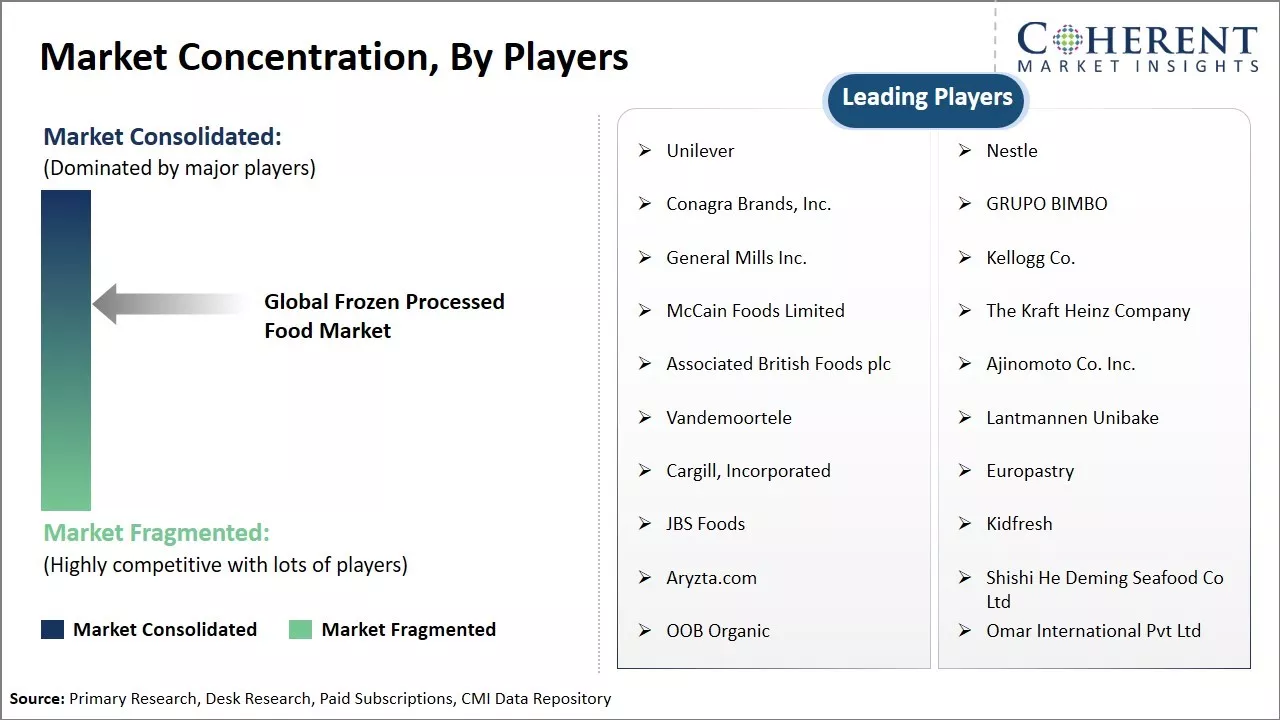
Get actionable strategies to beat competition: Request sample copy
Changing Family StructureThe structure of families has undergone massive changes over the past few decades. Dual income households are now the norm rather than the exception. Many families also have single parents who juggle child rearing duties alone. Elderly people are also preferring to live independently for longer. All these changes have significantly reduced the time availability at home to plan and prepare meals. Frozen processed foods help service the nutritional needs of such diverse family models. For example, a working mother can pop a frozen pizza in the oven rather than slaving over a hot stove after a long day. Senior citizens find ready meals healthier than eating out and easier on their budgets than cooking for one. Busy families now have safe, nutritious and hassle-free food options without compromising on taste or quality due to the growth of the frozen processed food industry.
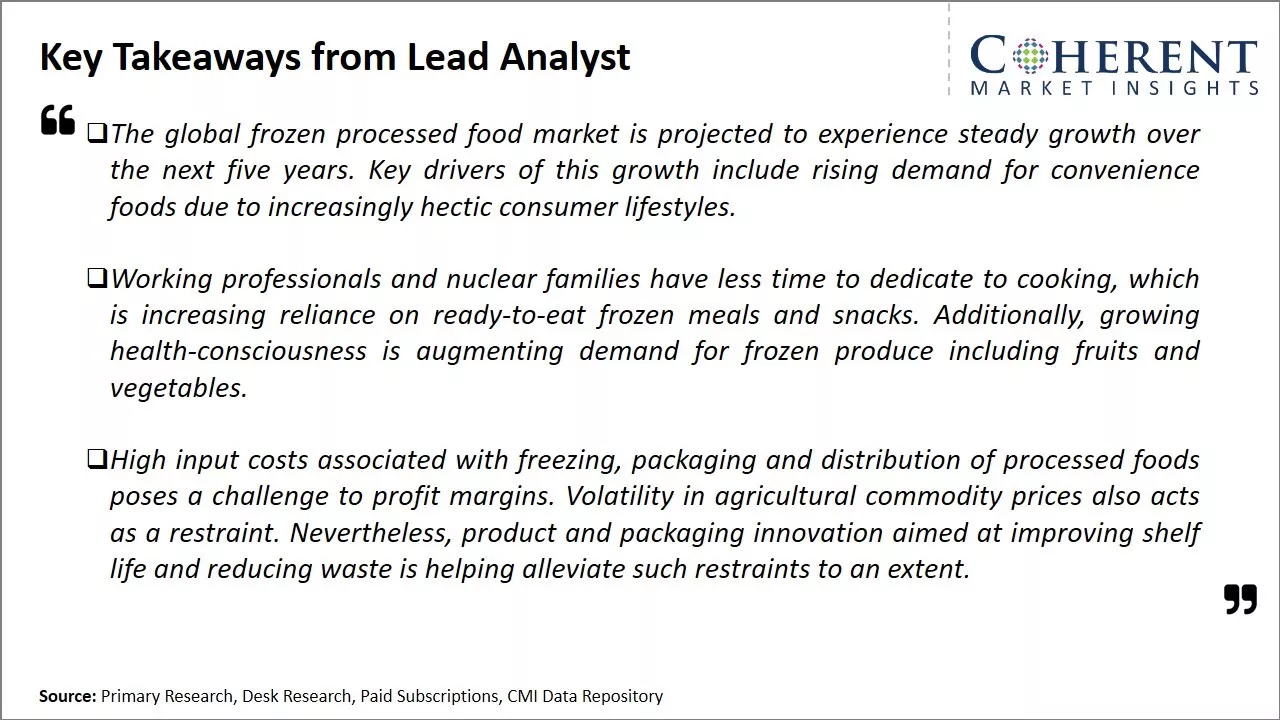
To learn more about this report, Request sample copy
Market Challenges: Changing consumer preferences towards fresh and healthy foodsGlobal frozen processed food market faces challenges from changing consumer preferences towards fresh and healthy foods. Rising health concerns associated with high sugar, salt, fat content of frozen meals boosts demand for better-for-you frozen options.
Market Opportunities: Developing products aligned with current health and wellness trends
Despite challenges, the frozen processed food market holds potential for growth by developing products aligned with current health and wellness trends. Offering frozen meals and snacks with clean label ingredients, more nutritional value, and diverse global flavors presents an opportunity to attract newer customers. With rising demands for convenience, there is also scope for frozen ready meals and appetizers that offer time-saving preparation at affordable price points.
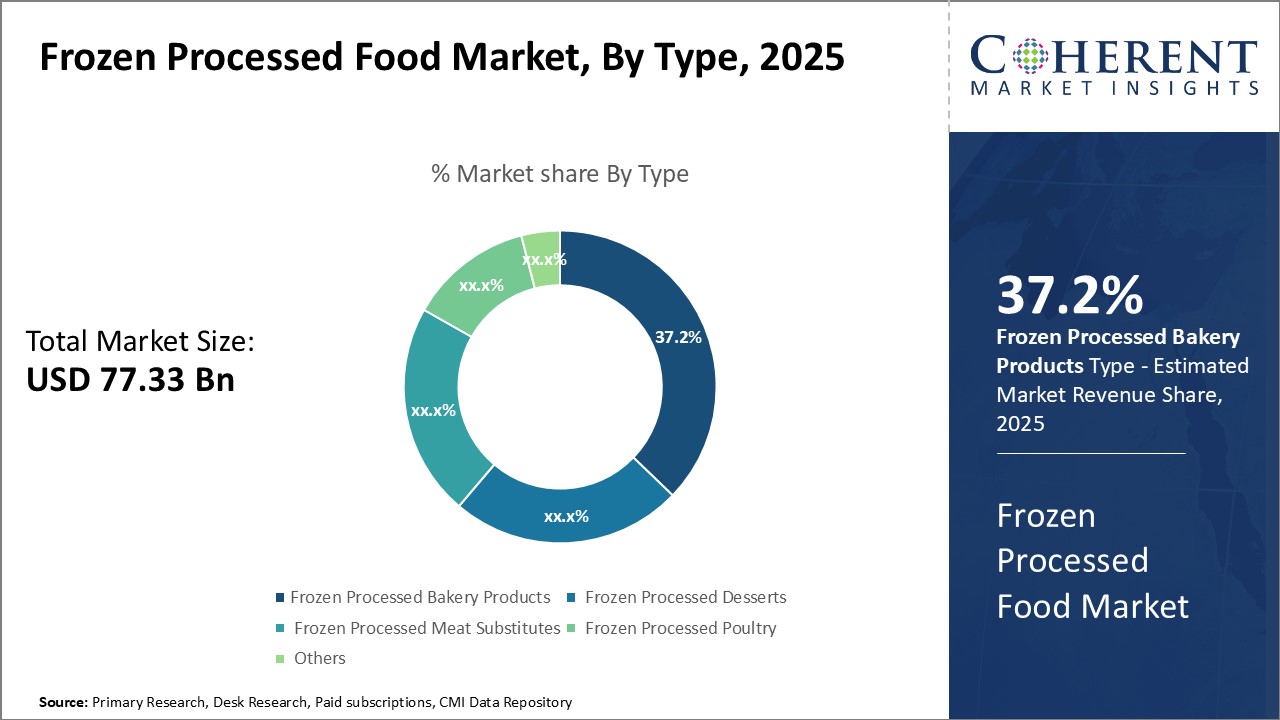
Discover high revenue pocket segments and roadmap to it: Request sample copy
Insights, By Type: Convenience and affordability boosts demand for frozen processed poultryFrozen processed poultry segment is estimated to contribute the 37.2% share of the global frozen processed food market in 2025, owing to convenience and affordability. As more people lead busy lives with less time to cook from scratch every night, frozen poultry products offer a solution. Boneless, skinless chicken breasts, turkey burgers, or chicken nuggets all can be prepared in under 30 minutes with little effort. The convenience of popping frozen poultry in the oven or microwave makes it an attractive weekday dinner option for families and individuals alike. Affordability is another key reason for frozen poultry's popularity. While fresh chicken and turkey can be pricey, frozen versions provide the same proteins at a more budget-friendly cost. This allows consumers to stretch their food dollar further and spend less to feed their households nutritious meat. As inflation puts pressure on consumer budgets globally, frozen poultry acts as an affordable alternative to pricier fresh or deli counter meats. Advancements in freezing and packaging technologies have also boosted frozen poultry's quality and shelf life in recent years. Products now stay fresher for longer in home freezers. Added marinades, breading, and sauces further enhance flavor and moisture.
Insights, By Distribution Channel: Supermarkets/ Hypermarkets segment is dominant in the market due to broad assortment and one-stop-shopping
Supermarkets/ Hypermarkets segment is estimated to contribute the 38.2% share of the global frozen processed food market due to their ability to offer consumers a wide assortment under one roof. Most frozen food shoppers appreciate getting all or most of their grocery needs met in a single trip. Supermarkets satisfy this preference with expansive stores housing everything from produce to packaged goods to meat and dairy. Within their frozen aisles, supermarket giants devote significant space to frozen processed items like meals, snacks, bakery products and more. Shoppers benefit from a one-stop assortment of familiar brands alongside private label and niche options. Whether stocking up for the week or browsing for a special meal, people can find inspiration without needing multiple locations. As consumer diets diversify, supermarkets adjust freezers accordingly to represent global flavors. Pricing also plays a role in supermarket dominance. As high-volume outlets, these leverage scale to offer competitive frozen food prices. With the greatest level of selection, value and convenience, supermarkets make themselves the obvious destination for regular frozen food stock-ups. Their massive frozen footprints cement their position as leaders in the distribution of this growing market.
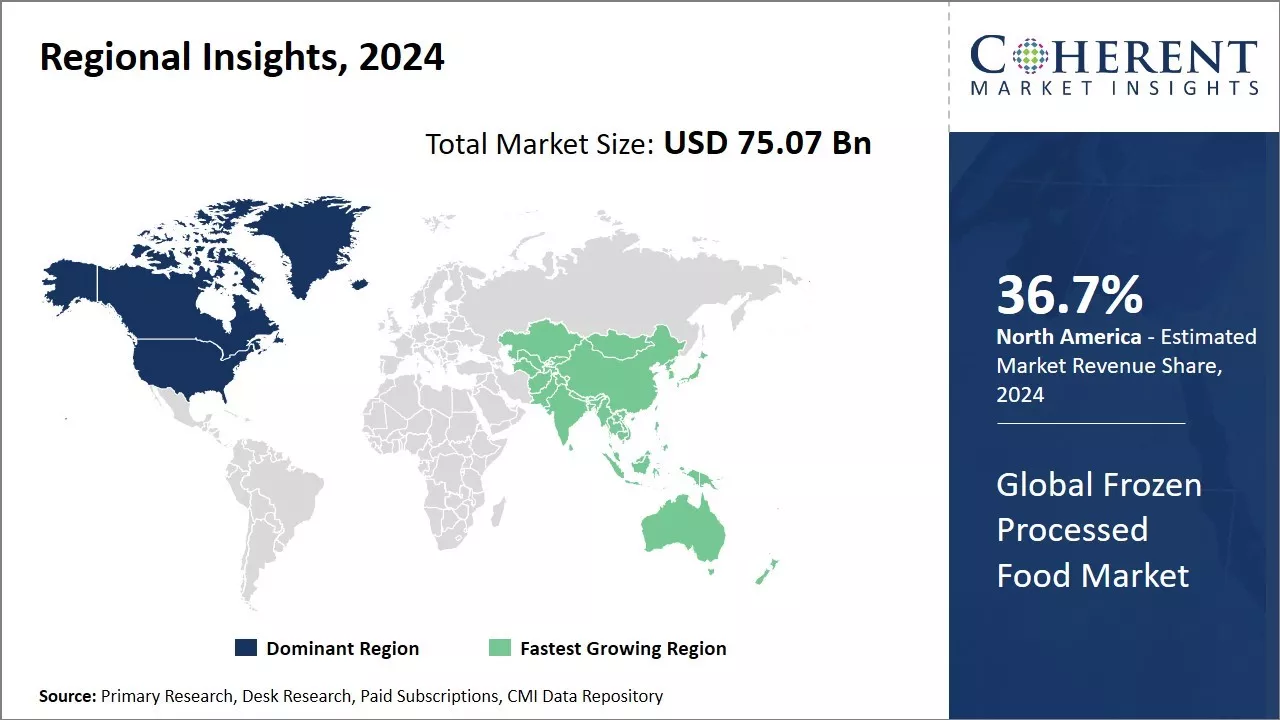
Need a Different Region or Segment? Customize now
North America has established itself as the dominant region in the global frozen processed food market with estimated 41.6% share in 2025. With a highly developed food processing industry and presence of major manufacturers, the U.S. and Canada account for the bulk of frozen processed food consumption in the region. The meal solutions and snacks segments within the frozen food category have seen strong growth over the last decade. Companies have utilized innovative packaging and launched single-serve frozen meals to cater to the busy lifestyles and eat-on-the-go culture in North America. Another key factor for North America's prominence has been aggressive marketing campaigns. Manufacturers promote their products through sports and cultural sponsorships, which have helped freeze foods gain further mainstream acceptance. International trade has also been a major growth lever. While North America maintains a trade surplus in frozen food, imports from other developed markets supplement local supply. This allows consumers access to a wide variety of cuisines without compromising on quality and pricing.
Among developing markets, Asia Pacific has emerged as the fastest growing region for frozen processed foods. Rapid urbanization and rising income levels in populous nations such as India and Indonesia is driving changes in dietary patterns and food consumption habits. While fresh foods remain predominant, time-pressed lifestyles are pushing consumers to explore convenient frozen alternatives. This helps local brands establish market presence internationally as well. Changing demographics with a growing working women population also make Asia an attractive promising region. Companies are responding by tailoring products to regional tastes, launching smaller affordable packs and educating consumers about product benefits like minimal food loss. The combination of favorable demand and supply dynamics have made Asia Pacific the force to watch out for in the global frozen food landscape.
Frozen Processed Food Market Report Coverage
| Report Coverage | Details | ||
|---|---|---|---|
| Base Year: | 2024 | Market Size in 2025: | USD 77.33 Bn |
| Historical Data for: | 2020 To 2024 | Forecast Period: | 2025 To 2032 |
| Forecast Period 2025 to 2032 CAGR: | 3.0% | 2032 Value Projection: | USD 95.17 Bn |
| Geographies covered: |
|
||
| Segments covered: |
|
||
| Companies covered: |
Unilever , Nestle , Conagra Brands, Inc., GRUPO BIMBO , General Mills Inc., Kellogg Co. , McCain Foods Limited , The Kraft Heinz Company , Associated British Foods plc, Ajinomoto Co. Inc., Vandemoortele , Lantmannen Unibake , Cargill, Incorporated , Europastry , JBS Foods , Kidfresh , Aryzta.com , Shishi He Deming Seafood Co Ltd, OOB Organic , Omar International Pvt Ltd |
||
| Growth Drivers: |
|
||
| Restraints & Challenges: |
|
||
Uncover macros and micros vetted on 75+ parameters: Get instant access to report
*Definition: Global Frozen Processed Food Market refers to the market for frozen food products that have been processed or prepared for consumption at a later time. This includes foods like frozen pizza, frozen ready meals, frozen meat and poultry products, frozen seafood products, frozen bakery products, and frozen fruits and vegetables.
Share
Share
About Author
Yash Doshi is a Senior Management Consultant. He has 12+ years of experience in conducting research and handling consulting projects across verticals in APAC, EMEA, and the Americas.
He brings strong acumen in helping chemical companies navigate complex challenges and identify growth opportunities. He has deep expertise across the chemicals value chain, including commodity, specialty and fine chemicals, plastics and polymers, and petrochemicals. Yash is a sought-after speaker at industry conferences and contributes to various publications on topics related commodity, specialty and fine chemicals, plastics and polymers, and petrochemicals.
Missing comfort of reading report in your local language? Find your preferred language :
Transform your Strategy with Exclusive Trending Reports :
Frequently Asked Questions
Joining thousands of companies around the world committed to making the Excellent Business Solutions.
View All Our Clients
US Reciprocal Tax Impact Analysis On Frozen Processed Food Market
Stay updated on tariff changes with expert insights and timely information